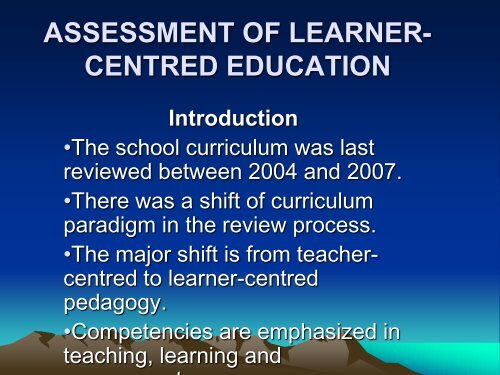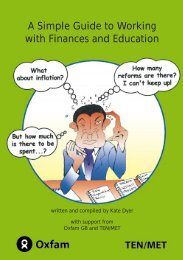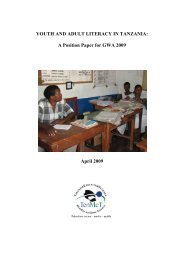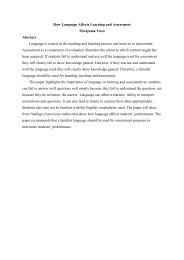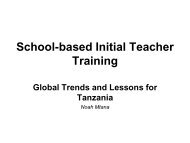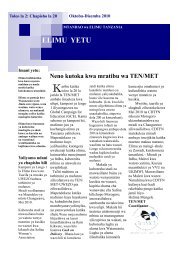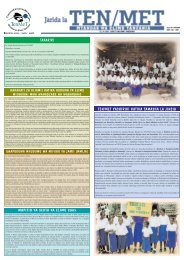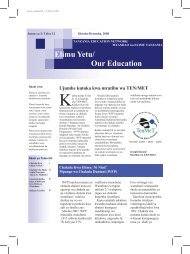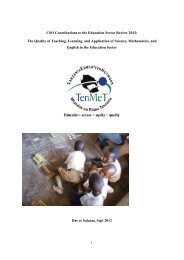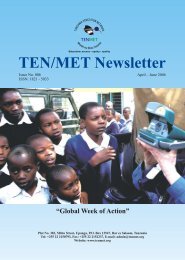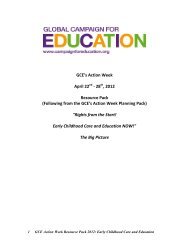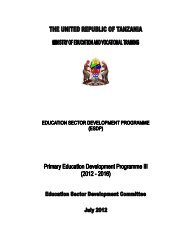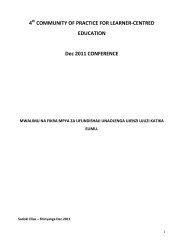ASSESSMENT OF LEARNER CENTRED EDUCATION
ASSESSMENT OF LEARNER CENTRED EDUCATION
ASSESSMENT OF LEARNER CENTRED EDUCATION
- No tags were found...
Create successful ePaper yourself
Turn your PDF publications into a flip-book with our unique Google optimized e-Paper software.
<strong>ASSESSMENT</strong> <strong>OF</strong> <strong>LEARNER</strong>-<strong>CENTRED</strong> <strong>EDUCATION</strong>Introduction•The school curriculum was lastreviewed between 2004 and 2007.•There was a shift of curriculumparadigm in the review process.•The major shift is from teachercentredto learner-centredpedagogy.•Competencies are emphasized inteaching, learning and
continued• A curriculum paradigm shift means thatthere has been a change in the way wedevelop, implement and assess the schoolcurriculum.• The curriculum implementation process isnow learner-centred and activity oriented.• The learner is now responsible for his/herown learning.
continued• The teacher is simply a facilitator oflearning and not a lecturer.• Learner’s pre-knowledge is now respectedand used in lesson implementation.• Learners are now involved in lessonpreparation, development, assessment,reflection and evaluation.• Assessment is now criterion-referenced asopposed to being norm-referenced.
Learner Involvement• Interactive and participatory methods ofteaching are emphasized.• Learning involves the development ofknowledge, skills, attitudes andcompetencies.• The maximized learner involvement inactivities during learning enhancesunderstanding, retention and memory.
Learning• Learning is a cognitive process whichoccurs in the human mind. It used to bedefined as a permanent change ofbehaviour.• Change of behaviour is evidence thatlearning has occurred.• The learning in lower animals is slightlydifferent from the learning in humans.
Creativity and Originality• Learners have to be positively critical ofnew knowledge. They should not learnnew knowledge as rigid dogma.• Learners should employ both deductiveand inductive approaches in theiractivities, thinking and reasoning.• Learners should participate actively in theprocess of creating and acquiring newknowledge.
Cooperative Assessment• Students should learn cooperatively byworking in small groups, from pairsonwards.• Cooperative learning must go hand inhand with cooperative assessment.• Scores or points obtained in a cooperativeactivity should be equally shared.• Peer assessment should be encouraged.
The Problem• The school curriculum has been reviewedto become competence based.• Competence based curriculum materialshave been developed and are in place.• Some teachers have been oriented incompetence based curriculumimplementation, but they are not yetfamiliar with competence basedassessment.
continued• This paper intends to enable teachers andother educationists to constructcompetence based question items for usein tests and examinations.• A well balanced assessment tool shouldhave question items which cover thewhole spectrum of academic domains(knowledge, skills, attitudes andcompetencies).
Involvement of Learners in TheirOwn Assessment• In a learner-centred assessment, thelearner participates in his/her ownassessment, and that of peers.• The learner keeps track of his/her ownacademic progress by keeping a portfolio.• Portfolios can be kept for practicalexperiments, project works and the resultsof exercises, tests and examinations.
Criterion-referenced Assessment• This type of assessment tests the extent towhich the learner has mastered therequired knowledge, skills andcompetencies according to the setobjectives.• The learner is assessed on his/hermastery of skills and competences ofperforming a task or solving a problem(the criterion).
Assessment of Group WorkStudents working as a group may be assessed forthe :• Quality of individual contributions in the groupactivities;• Extent of abiding to the given procedures andinstructions;• Extent of success or failure in particularactivities.• The quality of the products of their activities.
Facilitating Formative Assessment• Sharing learning goals with students.• Providing assessment feedback tostudents.• Students doing self assessmentindividually or in groups.• Students working towards explicit targets.• Students reflecting on the quality of theirwork, and how to remove any bottlenecks.
Purpose of Formative Assessment• To help learning of students by finding outwhere they are not making progress.• To reveal the particular difficulties thestudents are facing in their learningactivities.• To summarize achievements at certaintimes for keeping records, reporting toparents and motivating the students.
Assessment of the CompetencebasedCurriculum• Competence-based assessmentemphasizes what the learner can do morethan what s/he can simply remember.• Since learning is activity oriented andlearner-centred, the knowledge, skills andcompetences developed must beassessed formatively and summatively bydirect or indirect methods.
Assessment of the HigherCognitive Levels• Most of our tests have mainly assessedthe lowest cognitive level of knowledge.• Competence-based assessment coversthe whole spectrum of the cognitivedomain (knowledge, comprehension,application, analysis, synthesis andevaluation).
The Basic CompetenciesThe learner should be assessed in the followingmajor competences among many:• Critical and creative thinking;• Communication;• Numeracy;• Technological literacy;• Personal and social values and skills;• Independent learning.
continued• It is very important that teachers shoulddevelop the ability to constructcompetence based question items for usein their classroom exercises, tests andexaminations. In short, competence basedquestions tend to engage action verbsbelonging to the higher levels of thecognitive domain.
GROUP TASKWorking in small groups, participantsshould:i) Explain how each of the abovecompetences can be assessed.ii)Mention any competences they think isimportant but has not been mentioned.iii) Create at least one question item foreach of the competencies above.
Assessment of Critical andCreative Thinking• This competency enables the learners tobecome critical and question allphenomena, rather than acceptingeverything they are taught or read as soliddogma.• Critical and creative thinking is the basis offinding out new knowledge. If learners areto contribute new ideas and skills, theymust be critical and creative.
continuedIn order to assess this competence, theteacher should:• Find out the ability of the learners toquestion ideas as they acquire them fromdifferent sources;• Find out how the learner participatesactively in the process of developing andlearning new knowledge and skills;
continued• Observe learners’ originality and how theycontribute their own ideas and skills ingroup tasks and discussions;• Test learners’ personal learning initiativesand imaginative thinking;• Assess how learners evaluate ideas,processes and experiences as they arisein meaningful contexts;
Examples of Question Items on thisCompetence1) Write a two page description of what you thinkwill happen on your wedding day. (synthesis :creativity) ENGLISH2) If Christian Missionaries were so kind to bringreligion to Africa, could they also have a differentagenda of their own? (critical thinking) HISTORY3) Predict the consequences of abusing politicalpower (creativity : synthesis) CIVICS / HISTORY
continued4) Design an experiment to find out thecauses of poor plant growth on a fertileland. (creativity: synthesis) BIOLOGY /AGRICULTURE5) How would you advise your colleagueswho happen to be drug addicts as well assexually promiscuous? (creativity; criticalthinking: synthesis) CIVICS /PSYCHOLOGY / BIOLOGY
Assessment of CommunicationThis competency is focused on improvingthe learner’s understanding of thelanguage demands in the required areasof learning. In Tanzania, for example ,learners must develop competencies inthe languages of instruction as well asforeign languages such as French andArabic. Language proficiency is central tolearning in all subject areas.
continued• There are some subject-specific elementsof communication in every subject. Forexample, mathematics uses symbols andformulae, the sciences uses symbols,formulae and equations. Languages usepunctuation marks, and so on.• The teacher should be able to assess thelevels of mastery in all the elements ofcommunication.
continuedIn order to assess this competency, the teachershould:• Use vocabulary, structure and forms ofexpression which characterize specific areas ofstudy;• Use symbolic language such as symbols,formulae and equations in science and othersubjects;• Develop language skills such as grammar andcomprehension.
Examples of Question Items on thisCompetence1) Paraphrase the following sentence.(comprehension) LANGUAGES2) Categorize the following words intosimilar groups. (synthesis) LANGUAGES/ SCIENCES3) Summarize the story you have read intoonly two paragraphs (comprehensionand synthesis) LANGUAGES
continued4) Change the poem you have read into anarrative story. (comprehension; synthesis)LANGUAGES5) Read the passage and re-write it in your ownwords. (comprehension) LANGUAGES /HISTORY/ /CIVICS6) Write a short essay on the predicaments ofadolescent pregnancy. (synthesis)LANGUAGES / CIVICS / BIOLOGY /PSYCHOLOGY
Assessment of NumeracyThis competency intends to strengthenlearners’ in the understanding and use ofthe quantitative aspects of each subject.To assess this competency, the teachershould find out the extent to which thelearner can:• Use numerical knowledge and theinterrelationship of numbers to developunderstanding within subject areas;
continued• Develop knowledge and understanding ofhow to compute, measure, estimate,derive, extrapolate, and interpretnumerical data;• Use mathematical knowledge to solvenumerical problems in other disciplines ofknowledge and in real life.
Examples of Question Items on thisCompetence1) Convert some real numbers into logarithms.(application and synthesis) MATHEMATICS /SCIENCES2) Find the value of the unknown in the equation:3a + 3 = 24 (analysis) MATHEMATICS3) Convert some raw research data into statisticaldata (analysis; synthesis; application).MATHEMATICS / CIVICS / HISTORY /SCIENCES / BUSINESS
continued4) Draw charts and tables from some given rawdata (application; synthesis; analysis)MATHEMATICS / SCIENCES / BUSSINES.5) Factorize the following equations (analysis)MATHEMATICS / SCIENCES6) Derive the formula for calculating the area of acircle from basic principles (analysis; synthesis;application) MATHEMATICS / SCIENCES
Assessment of TechnologicalLiteracyThis competency is intended to strengthenlearners’ proficiency in the understanding anduse of the technology inherent in every aspect oflife. To assess this competence, the teachershould find out the extent to which the learnercan:• Develop technological capabilities in differentaspects of life;• Use science and technology, especially digitaltechnology, to solve various problems;
continued• Apply technological skills in mattersconcerning academic studies;• Appreciate the values and limitations ofscience and technology in real life;• Sort out the limitations and predicamentsof using technology and find ways to avoidthem.
Examples of Question Items on thisCompetency1) Use a calculator to solve the followingnumerical problems. (analysis;application) MATHEMATICS /SCIENCES / COMPUTER STUDIES2) Carry out volumetric analysis todetermine the unknown concentration ofa solution using a pH meter. Application;analysis) CHEMISTRY / BIOLOGY /AGRICULTURE / NUTRITION
continued3) Find out how an acid soil should beneutralized and fertilized. (application;analysis) CHEMISTRY / BIOLOGY /AGRICULTURE / GEOGRAPHY4) Why does meat cook faster in a pressurecooker than in a common pot?(application) CHEMISTRY / BIOLOGY /PHYSICS / NUTRITION
continued5) Prepare a sample of soap using an alkaliand a fat of your choice. (application;synthesis) CHEMISTRY / BIOLOGY /HOME MANAGEMENT6) Why are powdery detergents better thanordinary bar soaps? (application; analysis;evaluation) CHEMISTRY / BIOLOGY /HOME MANAGEMENT
Assessment of Social ValuesThis competency is intended to strengthenlearners’ proficiency in the understandingand use of the personal and social valuesin every aspect of life. It falls under theaffective domain of the Bloom’sTaxonomy. To assess this competency,the teacher should find out the extent towhich the learner can:
continued• Conceptualize how culture shapes peoples’thoughts, attitudes, perceptions and values;• Apply appropriate values, norms, attitudes andbeliefs in real life;• Develop compassionate, empathetic and fairmindedattitudes needed in society;• Treat their culture and those of other people withrespect;• Avoid any forms of prejudice, discrimination,racism and inequality.
Examples of Question Items on thisCompetency1) What is the advantage of learning fromothers and respecting other peoples’points of view? (receiving) CIVICS /PSYCHOLOGY2) Why is it important to be empathetic,sympathetic and responsive to otherpeoples’ needs? (responding) CIVICS /RELIGION / PSYCHOLOGY
continued3) How would you rate a student who scoreshigh in a test through cheating? (valuing)PSYCHOLOGY / <strong>EDUCATION</strong>4) How would you ensure that there isgender balance in a classroom setting?(organization) PSYCHOLOGY / CIVICS
Assessment of IndependentLearningThis competency is intended to strengthen alearner’s proficiency in independentlearning. It also falls under the affectivedomain of the Bloom’s Taxonomy. Toassess this competency, the teachershould find out the extent to which thelearner can:• Become self reliant, confident andmotivated for lifelong learning.
continued• Develop the skills needed to acquireknowledge from various sources;• Face the challenges involved in theacquisition of new knowledge;• Be ready to learn from others withoutbecoming dependent on them;• Participate actively in the process seekingor developing new knowledge.
Examples of Question Items on thisCompetency1) If you were posted in a foreign office,how would you feel working with peopleof different religion, race or tribe?(receiving) CIVICS / RELIGION /GEOGRAPHY2) What are your opinions about thebenefits and limitations of learning fromothers and working in small groups?(responding) ALL SUBJECTS
continued3) How do you value the knowledge youseek and acquire personally from sourcesother than your teacher (libraries, peers,elders parents, journals, periodicals,newspapers and mass media? (valuing)ALL SUBJECTS.
CONCLUSION• Given that our curriculum is competencebased, the question items we use inexercises, tests and examinations mustalso be competence based.• The most important aspect aboutcompetence based question items is thatthey stimulate our cognitive capacities inthe higher mental process.
continued• For example, some competence basedquestions use the verbs such as “WHY?” ,“HOW?”• The learner is asked to think deeply beforeresponding. By so doing, thinking capacityis developed in the learners.• The learner must be able to give reasonsfor various phenomena.
ENDAsanteFor those interested in “paradigm shifts” Irecommend “The Structure of scientificrevolutions”, by Thomas Kuhn


